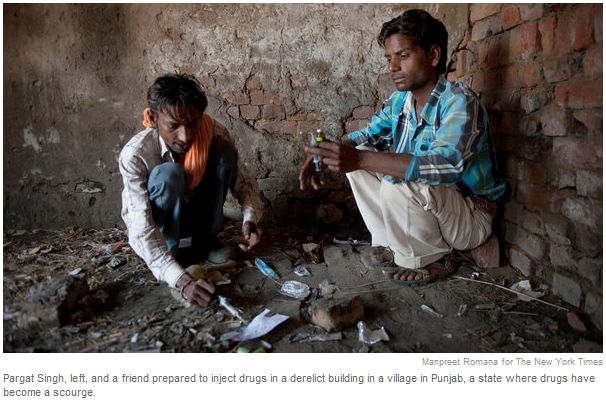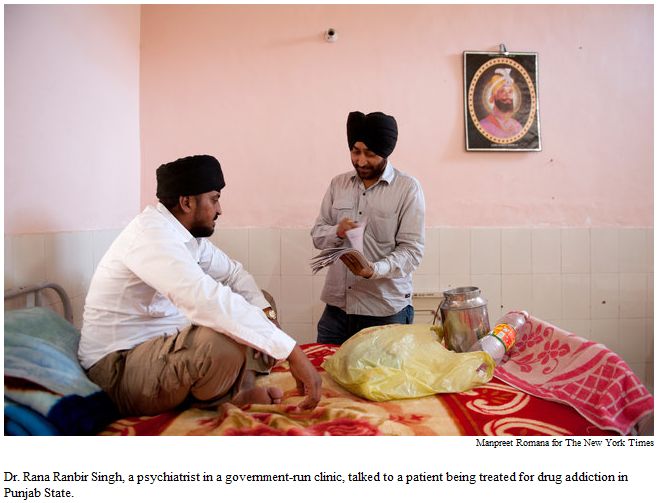 KAZIKOT
VILLAGE, India — In this village not far from the Pakistani border, the
wheat harvest is only days away. Water buffaloes are resting in the shade.
Farmers are preparing their fields.
KAZIKOT
VILLAGE, India — In this village not far from the Pakistani border, the
wheat harvest is only days away. Water buffaloes are resting in the shade.
Farmers are preparing their fields.
And drug addicts like Pargat Singh are crouched in
the shadows, injecting themselves with cocktails of synthetic drugs.
Last Thursday, just after 11 a.m., Mr. Singh
followed another man into a dark corner of a decrepit building favored by
the roughly 50 addicts in this village. Cracked prescription bottles
littered the ground. The other man jabbed a syringe into his arm and
injected a blend of prescription drugs that delivers a six-hour high.
“Save some for me,” said Mr. Singh, who is H.I.V. positive and stricken with
tuberculosis. He told a photographer: “Shoot my picture. Make me famous.”
Throughout the border state of Punjab, whether in villages or cities, drugs
have become a scourge. Opium is prevalent, refined as heroin or other
illegal substances. Schoolboys sometimes eat small black balls of opium
paste, with tea, before classes. Synthetic drugs are popular among those too
poor to afford heroin.
The scale of the problem, if impossible to quantify precisely, is undeniably
immense and worrisome. India has one of the world’s youngest populations, a
factor that is expected to power future economic growth, yet Punjab is
already a reminder of the demographic risks of a glut of young people. An
overwhelming majority of addicts are between the ages of 15 and 35,
according to one study, with many of them unemployed and frustrated by unmet
expectations.
For the Punjab government, the problem is hardly unknown. Private drug
treatment centers, some run by quacks, have proliferated across the state,
and treatment wards in government hospitals have seen a surge in patients.
Three years ago, a state health official warned in a court affidavit that
Punjab risked losing a whole generation to drugs. Roughly 60 percent of all
illicit drugs confiscated in India are seized in Punjab.
Yet when Punjab held state elections this year, the candidates rarely spoke
about drug abuse. In fact, India’s Election Commission said that some
political workers were actually giving away drugs to try to buy votes. More
than 110 pounds of heroin and hundreds of thousands of bottles of bootleg
liquor were seized in raids. During the elections, party workers in some
districts distributed coupons that voters could redeem at pharmacies,
activists said.
“We have encountered the problem of liquor during elections in almost all
states,” S. Y. Quaraishi, India’s chief election commissioner, told
reporters. “But drug abuse is unique only to Punjab. This is really of
concern.”
Punjab’s reluctance to treat the drug situation as a full-blown crisis is
partly because the state government itself is dependent on revenue from
alcohol sales. Roughly 8,000 government liquor stores operate in Punjab,
charging a tax on every bottle — an excise that represents one of the
government’s largest sources of revenue. India’s comptroller found that
liquor consumption per person in Punjab rose 59 percent between 2005 and
2010.
“We are promoting addiction in our state,” said Dr. Manjit Singh Randhawa,
the city of Amritsar’s civil surgeon, a job akin to chief medical officer.
“I’m getting calls from people saying they have lost their children, they
have lost their breadwinners. In every village, people are falling prey to
this drug abuse.”
 Ranvinder
Singh Sandhu, a sociologist in Amritsar, surveyed 600 drug addicts in rural
and urban areas of Punjab and found that they were usually young, poor and
unemployed. He said that most villages did not have health clinics but did
have three or four drugstores, which often made sizable profits selling
pills and other synthetic drugs to addicts who cannot afford heroin.
Ranvinder
Singh Sandhu, a sociologist in Amritsar, surveyed 600 drug addicts in rural
and urban areas of Punjab and found that they were usually young, poor and
unemployed. He said that most villages did not have health clinics but did
have three or four drugstores, which often made sizable profits selling
pills and other synthetic drugs to addicts who cannot afford heroin.
Mr. Sandhu said he had completed his study six years ago, at the request of
Punjab’s governor, yet had never been contacted by any state official about
the findings. “The state is not conceiving it as a social problem,” he said.
“They are conceiving it as a personal problem.”
Opium has a long history in Punjab, and was commonly and legally consumed
here before India and Pakistan gained independence in 1947. Today, Punjab is
a primary gateway for opiates smuggled into India from Pakistan and
Afghanistan. Opium is also grown legally in India for medicinal purposes,
and some of the crop arrives in Punjab on the black market.
The problem is prevalent in middle-class enclaves, where some users are
hooked on heroin. One impoverished neighborhood of Amritsar, called
Maqboolpura, is known as the Village of Widows — because so many young men
have died of drug abuse.
“Drugs are available everywhere,” said Ajit Singh, who has spent 13 years
running a school for poor children affected by drug abuse. Of the school’s
656 students, roughly 70 percent have lost a parent to drugs. One girl, a
fifth grader, lost five uncles and her father to drug-related deaths.
In Kazikot Village, about a two-hour drive from Amritsar, a local
nongovernmental organization tries to prevent the spread of H.I.V. by
regularly distributing clean syringes to addicts. The group’s workers say
there are 48 hard-core addicts in the village (out of more than 2,000
people) but that many other people use drugs. Government officials have
sponsored “camps” here, with health officials providing antidrug information
or trying to persuade addicts to undergo treatment — neither of which,
villagers say, has been successful.
“Everybody knows about it,” said Hira Singh, a local shopkeeper. “But nobody
does anything to stop it.”
Mr. Singh, the H.I.V.-positive addict, lives at his parents’ home with his
younger brother and his sister. He started using drugs at age 15, and then
quit school. He worked for several years pulling a rickshaw, got married and
had a daughter. Later, his wife gave premature birth to twin sons, who died.
Unable to abide her husband’s drug use, his wife left him and their
daughter, Harpreet, 3.
“He steals things from the house,” said Seema Kaur, his sister. “Sometimes,
he steals money.”
Mr. Singh, now 29, said he had tried many times to quit using drugs, but the
urge was too strong. Because of his tuberculosis, he said, he is careful not
to get to close to his daughter. “I play with her from a distance,” he said.
“I try not to hug her, so that she doesn’t get infected.”
He added: “My future is finished. I am basically dead now.”
Hari Kumar contributed reporting from Kazikot Village, and Nikhila Gill from
New Delhi.
